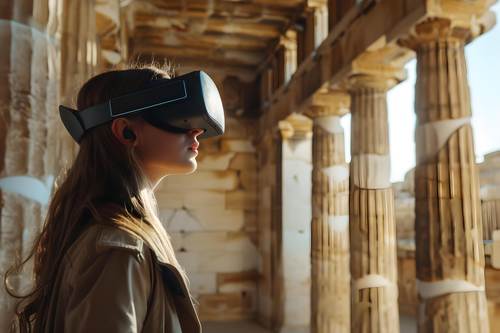
HUET Thomas
- School of Archaeology, University of Oxford, Oxford, United Kingdom
- Computational archaeology, Dating, Europe, Landscape archaeology, Mediterranean, Neolithic, Protohistory, Remote sensing, Rock art, Spatial analysis, Symbolic behaviours
- recommender
Recommendation: 1
Review: 1
Recommendation: 1

Virtual Reality Tours as an Immersive Approach to Archaeology in Higher Education
A roadmap for implementing VR-based teaching courses in archaeology
Recommended by Thomas Huet based on reviews by 3 anonymous reviewersVirtual Reality (VR), as a component of Extended Reality (XR), enables the visualization and exploration of archaeological sites and artifacts that are otherwise inaccessible or lost due to time, decay, or physical access constraints. As is common in archaeology, when a new technology becomes available, it is incorporated into the archaeologist's toolbox, but there remains a need to identify workflows and best practices.
The paper entitled 'Virtual Reality Tours as an Immersive Approach to Archaeology in Higher Education,' authored by Robert Stephan, Aviva Doery, and Caleb Simmons, presents a significant scholarly contribution to the practical integration of VR (360-degree recordings) in college archaeology courses, starting with the upcoming course titled 'Seven Wonders of Ancient Greece.' The manuscript includes a well-structured and up-to-date literature review and a relevant discussion on enhancing accessibility to international study experiences through VR technology. It explicitly outlines the phases of the project yet to be implemented and details the steps for implementing VR in educational settings, from device requirements to the evaluation of knowledge acquisition, including equipment cost and technological accessibility. The paper demonstrates a comprehensive understanding of the broader implications of integrating such technologies into mainstream curricula.
Although the reusability of geolocated and timestamped 360-degree recordings is not directly addressed, this paper serves as a solid handbook and a valuable roadmap for researchers and educators aiming to establish VR-based teaching projects in archaeology.
References
Robert Stephan, Aviva Doery, Caleb Simmons (2024) Virtual Reality Tours as an Immersive Approach to Archaeology in Higher Education. Zenodo, ver.3 peer-reviewed and recommended by PCI Archaeology https://doi.org/10.5281/zenodo.13255252
Review: 1

Analysis of the Abundance of Radiocarbon Samples as Count Data
Beyond the Sum: A Poisson Approach to Radiocarbon Analysis
Recommended by Jonathan Hanna based on reviews by Thomas Huet and 1 anonymous reviewerArchaeological data is inherently uncertain, which is probably why Bayesian approaches have become increasingly valued within the discipline. For radiocarbon analysis, instead of pinpointing one "true" date, Bayesian methods embrace probability, telling us how likely a sample falls within different date ranges based on what we already know (the prior) and what our data tells us (the posterior).
In this new paper, Miguel de Navascués and colleagues offer a method for treating radiocarbon dates as count data (generated through a Poisson process), rather than viewing them as draws from a probability distribution. This shift allows them to model the expected number of samples per year and incorporate uncertainty in both the timing and total number of samples. The result is a more natural representation of how radiocarbon samples accumulate in the archaeological record over time. (They then demonstrate the method using data from Britain and Ireland, revealing patterns that both confirm and refine our understanding of population changes during key transitions, including a possibly earlier start to the Neolithic demographic expansion.)
Overall, the paper represents a valuable contribution to quantitative archaeology that complements, rather than replaces, existing approaches like Sum Probability Distributions (SPDs) and end-to-end Bayesian methods (e.g., see Crema 2022 and Price et al. 2021).
While mathematically heavy, the paper is accompanied by well-annotated R scripts that I encourage readers to experiment with. For researchers working with radiocarbon data, particularly those investigating demographic change or cultural transmission, the methods presented here offer important new analytical possibilities for understanding past human dynamics. Sometimes, to move forward, we just need to count differently.
References
Crema, E. R. (2022), Statistical Inference of Prehistoric Demography from Frequency Distributions of Radiocarbon Dates: A Review and a Guide for the Perplexed. Journal of Archaeological Method and Theory 29(4):1387–1418. https://doi.org/10.1007/s10816-022-09559-5
de Navascués, M., Burgarella, C. & Jakobsson, M. (2025) Analysis of the Abundance of Radiocarbon Samples as Count Data. Zenodo, ver.3 peer-reviewed and recommended by PCI Archaeology https://doi.org/10.5281/zenodo.13381596
Price, M. H., Capriles, J. M., Hoggarth, J. A., Bocinsky, R. K., Ebert, C. E. & Jones, J. H. (2021) End-to-End Bayesian Analysis for Summarizing Sets of Radiocarbon Dates. Journal of Archaeological Science 135:105473. https://doi.org/10.1016/j.jas.2021.105473